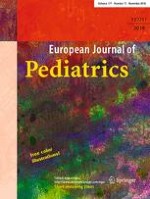Erschienen in:

22.08.2018 | Original Article
Neonatal screening in the Czech Republic: increased prevalence of selected diseases in low birthweight neonates
verfasst von:
Jan David, Petr Chrastina, Hana Vinohradska, Eva Al Taji, Andrea Holubova, Eva Hlidkova, Viktor Kozich, Felix Votava
Erschienen in:
European Journal of Pediatrics
|
Ausgabe 11/2018
Einloggen, um Zugang zu erhalten
Abstract
Neonates with low birthweight (LBW) represent a vulnerable population. This retrospective study analyzed the birth frequency of diseases detected by neonatal screening (NBS) in normal and LBW neonates in the Czech Republic. Between years 2002 and 2016, the number of screened disorders in the Czech Republic gradually increased from two to 13. Prevalence of screened diseases was calculated for cohorts ranging from 777,100 to 1,277,283 neonates stratified by birthweight. Odds ratio of the association of LBW with each disease was calculated and statistical significance was evaluated using the chi-square test or Fisher’s exact test, as appropriate. Three diseases were associated with higher risk of prevalence in LBW neonates, namely congenital hypothyroidism (OR 2.50, CI 1.92; 3.25), cystic fibrosis (OR 2.44, CI 1.51; 3.94), and long chain 3-hydroxyacyl-CoA dehydrogenase deficiency (LCHADD) (OR 7.74, CI 2.18; 27.42).
Conclusion: Although the underlying mechanisms are not well understood, results can be hypothesized that LBW (respectively prematurity) may lead to the secondary and often transitory hypothyroidism while cystic fibrosis and LCHADD may manifest already prenatally and result into preterm birth and LBW.
What is Known:
• The percentage of low birthweight (LBW) neonates in the Czech Republic has been increasing.
• Previously published studies reported positive association between LBW and congenital hypothyroidism and cystic fibrosis. |
What is New:
• The association between LCHADD and LBW has not yet been described.
• LBW can be the first manifestation of cystic fibrosis and LCHADD.
|











